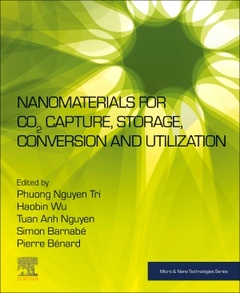Nanomaterials for CO2 Capture, Storage, Conversion and Utilization Micro and Nano Technologies Series
Coordonnateurs : Nguyen Tri Phuong, Wu Haobin, Barnabe Simon, Benard Pierre, Nguyen Tuan Anh

The gradual increase of population and the consequential rise in the energy demands in recent years have led to the widespread use of fossil fuels. CO2 transformation by various processes is considered as a promising alternative technology. This book sets out the fundaments of how nanomaterials are being used for this purpose.
Nanomaterials for CO2 Capture, Storage, Conversion and Utilization summarizes the research, development and innovations in the capture, storage, transformation and utilization of CO2 into useful products and raw chemicals for industry. This is achieved by using advanced processes such as CO2 reforming, bi-reforming and tri-reforming of hydrocarbons or biomass derivatives; homogeneous and heterogeneous hydrogenation; photochemical reduction; photoelectrochemical reduction; electrochemical reduction; biochemical reduction; supercritical CO2 technology; advanced catalyst synthesis for CO2 conversion; organic carbonates for polymers synthesis from CO2, and CO2 capture and sequestration. The systematic and updated reviews on the mentioned sectors, especially on the use of nanotechnology for the transformation of CO2 is scarce in the literature. Thus, the book addresses the recent knowledge gaps and potential solutions of the storage, utilization and transformation of CO2 as well as its promising applications.
This is an important reference source for materials scientists, engineers and energy scientists who want to understand how nanotechnology is helping us to solve some of the world?s major energy problems.
1. CO2 capture, storage, transformation and utilization: an introduction 2. Photoelectrochemical reduction of carbon dioxide 3. Nanocatalyst for CO2 hydrogenation 4. Porous polymers based adsorbent materials for CO2 capture 5. From Nanoparticle to Single Atom catalyst for Electrocatalytic Reduction of Carbon dioxide 6. Nanomaterials for photocatalytic reduction of carbon dioxide 7. Nanomaterials for CO2 conversion to valuable compounds 8. Nanomaterials for photocatalytic and cold plasma catalytic hydrogenation of CO2 to CO, CH4 and CH3OH 9. Electrochemical reduction of CO2 using shape-controlled nanoparticles 10. Conversion CO2 towards valuable compounds 11. Nanomaterials for photocatalytic reduction of carbon dioxide 12. CO2 adsorption with Covalent Organic Frameworks (COF) 13. Reduction of carbon dioxide using nanophotocatalysts 14. 2D nanomaterials for CO2 Reduction and transformation
Haobin Wu is a Professor at the School of Materials Science and Engineering, Zhejiang University, China. His research interests are metal-organic framework-related materials for sustainable energy, designed synthesis of micro-/nanostructured materials, electrochemical energy storage technologies, and electrocatalysis and electrochemical production of fuel
- Shows how nanomaterials are being used to create more efficient CO2 capture, storage and conversation systems
- Outlines the major nanomaterials-based techniques to create such systems
- Assesses the major challenges in using nanomaterials for energy capture, storage and conversion
Date de parution : 04-2021
Ouvrage de 394 p.
19x23.3 cm
Thèmes de Nanomaterials for CO2 Capture, Storage, Conversion and... :
Mots-clés :
?Active sites; And nanohollow structures; Artificial photosynthetic system; Atmosphere; Atmospheric; CO2 adsorption; CO2 hydrogenation; CO2 photoreduction; CO2 reduction; CO2 reduction (atomistic hydrogenation); CO2 sequestration; CO2 to fuel/chemical conversion; Capturing; Carbon capture and storage (CCS); Carbon cycle; Carbon dioxide; Carbon dioxide reduction; Carbon dioxide utilization; Catalyst criteria (design); Catalysts; Catalytic; Chemicals; ClHmOn valuable compounds; Climate change mitigation; Condensation reaction; Covalent organic frameworks; Cyclic and liner carbonate; Electrocatalysis; Electrochemical; Electronic structure; Electrons transfer; Emissions; Energy; Energy conversion; Environment; Environmental; Fossil; Fuel; Global warming; Greenhouse; Greenhouse gas; Heterogeneous catalysts; Hydrocarbons; Industrial; Liquid energy fuel; Metal atoms; Metal nanocatalysts; Nanocomposites; Nanocrystalline; Nanomaterials; Nanoparticles; Nanoporous; Nanostructured (nanoparticulated/mesoporous) photocatalyst; Nanotubes; Photocatalysis; Photochemical; Photoelectrochemical CO2 reduction; Photoreduction; Plasma; Polymer; Porous materials; Product selectivity; Products; Reaction; Reactive radical species (building blocks); Redox (electrochemical) nature; Semiconducting solar-energy materials; Shaped-controlled; Single-atom catalyst; Solar fuels; Standard redox potentials; Surface structure; Sustainable development; Technology; Temperature; Thermochemical; Titania-based nanomaterials; Transient H-atom generation; Value-added chemicals; Value-added products; Visible light responsive



